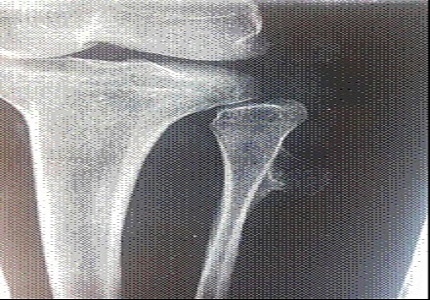Proximal fibular osteochondroma causing splitting of common peroneal nerve leading to neuropathy in an adult – a rare case report
Abstract
Osteochondroma is the most common benign primary tumor of appendicular skeleton arising from the metaphyseal or metadiaphyseal region of long bones and are most commonly seen around the knee. A proximal fibular osteochondroma may distort the normal anatomical course of nerves and it may lead to vascular compression syndromes or peroneal nerve paralysis. We report a case of proximal fibular osteochondroma causing splitting of common peroneal nerve leading to neuropathy in an adult. Our article concludes that osteochondroma of proximal fibula could be responsible for common peroneal nerve palsy due to compression or entrapment and in such cases decompression of nerve should not be delayed. Moreover, we also report that osteochondroma causing splitting of midsubstance of common peroneal nerve which may surprise surgeon intraoperatively. Through this case report, we are hoping to alert surgeons that this problem may occur, and care should be taken to identify the entire common peroneal nerve prior to removal of the osteochondroma.
Downloads
References
2. Mootha AK, Saini R, Dhillon M, Bali K, Dhatt SS,Kumar V. Modified resection technique for proximal fibular osteochondromas .Orthopaedics & Traumatology: Surgery & Research 2011;97(5):569–573.
3. Kumar M, Malgonde M, Jain P. Osteochondroma arising from the proximal fibula: a rare presentation. J Clin Diagn Res. 2014 Apr;8(4):LD01-3. doi: 10.7860/JCDR/2014/7541.4292. Epub 2014 Apr 15. [PubMed]
4. D'Ambrosia R, Ferguson AB Jr. The formation of osteochondroma by epiphyseal cartilage transplantation. Clin Orthop Relat Res. 1968 Nov-Dec;61:103-15. [PubMed]
5. Kim DH, Kline DG. Management and results of peroneal nerve lesions. Neurosurgery. 1996 Aug;39(2):312-9; discussion 319-20. [PubMed]
6. Salter RB. Textbook of Disorders and Injuries of the Musculoskeletal System. 2nd ed. Baltimore, MD: William & Wilkins; 1983.
7. Paik NJ, Han TR, Lim SJ. Multiple peripheral nerve compressions related to malignantly transformed hereditary multiple exostoses. Muscle Nerve. 2000; 23(8):1290-1294.
8. Urushidani H. [The funicular pattern of the sciatic nerve in Japanese adults (author's transl)]. Nihon Geka Hokan. 1974 Jul 1;43(4):254-75.



 OAI - Open Archives Initiative
OAI - Open Archives Initiative


